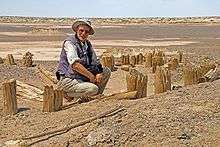Christoph Baumer
Christoph Baumer (born June 23, 1952 in Zurich) is a Swiss scholar and explorer. From 1984 onwards, he has conducted explorations in Central Asia, China and Tibet, the results of which have been published in numerous books, scholarly publications and radio programs.

Life
Baumer grew up in the Swiss Canton of Thurgau. His father was a businessman; his mother had been a war correspondent for the French national radio station and reported during the Finnish-Russian war in the winter of 1939–1940. Sven Hedin, the renowned explorer of Asia, aided her return to occupied Belgium, at that time her home. As a young boy, Baumer was already fascinated by the travel reports of Hedin, and these likely laid the foundation for Baumer's later development. After graduation from High School, he studied Psychology, Philosophy and Art History at the University of Zurich.
Since 1996, he has worked as a freelance author with emphasis on the cultural history of Central Asia. Christoph Baumer is Founding Member and President of the Society for the Exploration of EurAsia.
Exploration in the Taklamakan Desert
In 1994, Baumer led the First International Taklamakan Expedition, and was the first Westerner to reach the ancient oasis of Niya and Loulan since the 1930s.
The Second International Taklamakan Expedition followed in 1998. Christoph Baumer was the first visitor to the ancient ruined city Dandan Oilik in the Taklamakan Desert since Emil Trinkler and Walter Bosshard in 1928. Results of this expedition were, among others, the rediscovery and excavation of unknown ruins in Dandan Oilik and Buddhist murals dating from the mid-8th century A.D.;[1] the discovery of a paper document from the 7th/8th century set in the Khotanese language, i.e. in Brahmi script; the discovery of a very rare stone inscription in Kharoshthi from the 3rd century A.D. in the ruined city Endere; and the rediscovery of a Tibetan mural from 790. From this expedition stemmed the ZDF (Zweites Deutsches Fernsehen) documentary "The Lost City of Taklamakan" by Jon Jerstad (Also as domestic German version: Land of No Return' by Jon Jerstad and Viktor Stauder.)
In 2003, Baumer conducted the Third International Taklamakan Expedition in collaboration with the Archaeological Institute of Ürümqi, Xinjiang and with a representative of the University of London, during which he made finds north of Qiemo from the Neolithic Age (4th – 3rd millennium B.C.)
In 2007, he led the Fourth International Taklamakan Expedition into unexplored regions of the Lop Nor Desert. There he discovered, among others, a heretofore-unknown settlement, dating from approximately 100 B.C. – 400 A.D.[2]
In 2009, he led the Fifth International Taklamakan Expedition into the unexplored ancient delta of the River Keriya in the centre of the desert, and discovered two unknown graveyards: Satma Mazar (Iron Age) and Ayala Mazar (Bronze Age).[3]
Other explorations
Further expeditions took Baumer to southern Tibet in 1996, where he discovered in the former monastery Serkar Guthok hitherto unknown murals from the early 12th century; and in 1997 again to southern Tibet, where he discovered in the Pa-Lha-Puk Monastery the oldest existing murals of the Bön religion - from the early 15th century - in all of Tibet.
In the years 2000 to 2005 he researched and documented all relevant cultural relics of the Assyrian Church of the East, from southeastern Turkey to Mongolia, China and southern India.
In the years 1993, 2006 and 2007 he visited and documented all Buddhist monasteries of Mount Wutai Shan, northwestern China.
Bibliography
- The History of Central Asia (Volumes One, Two, Three, Four), I.B.Tauris, London. volume one =ISBN 978-1-78076-060-5
- China's Holy Mountain: An Illustrated Journey into the Heart of Buddhism. I.B.Tauris, London, 2011. ISBN 978-1-84885-700-1
- Tibet's Ancient Religion: Bön. Weatherhill and Orchid Press, 2002. ISBN 974-524-011-7 (Asia & Europe), ISBN 0-8348-0517-0 (Americas)
- Southern Silk Road: In the Footsteps of Sir Aurel Stein and Sven Hedin. 2nd revised edition, Orchid Press, 2004. 974-8304-39-6 (Paperback), ISBN 974-8304-38-8 (Hardback)
- Eastern Tibet: Bridging Tibet and China. Orchid Press, 2005. ISBN 974-524-064-8
- The Church of the East: An illustrated History of Assyrian Christianity. I.B.Tauris, London, 2006. ISBN 1-84511-115-X
- Traces in the Desert: Journeys of Discovery across Central Asia. I.B.Tauris, London, 2008. ISBN 978-1-84511-337-7
References
- Anupa Pande: The art of Central Asia and the Indian subcontinent in cross-cultural perspective. Aryan Books International in association with National Museum Institute of History of Art, New Delhi 2009, pg. 179
- Anupa Pande: The art of Central Asia and the Indian subcontinent in cross-cultural perspective. Aryan Books International in association with National Museum Institute of History of Art, New Delhi 2009, pg. 179
- Christoph Baumer: The Ayala Mazar – Xiaohe Culture. New archaeological discoveries in the Taklamakan Desert, China. Journal of the Royal Society for Asian Affairs, London, 1/2011
External links
- Publications by and about Christoph Baumer in the catalogue Helveticat of the Swiss National Library